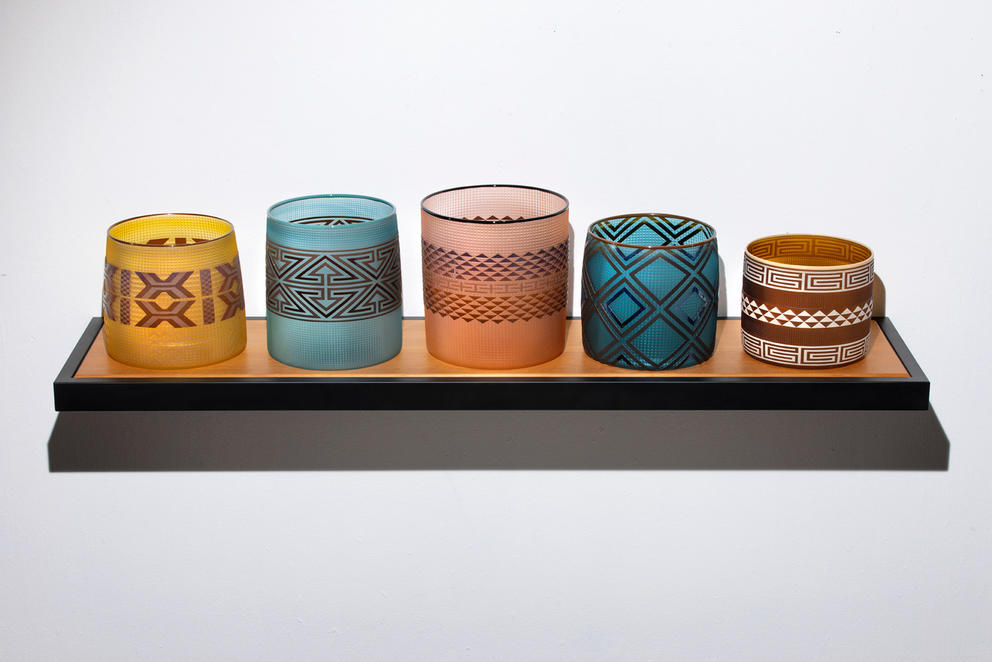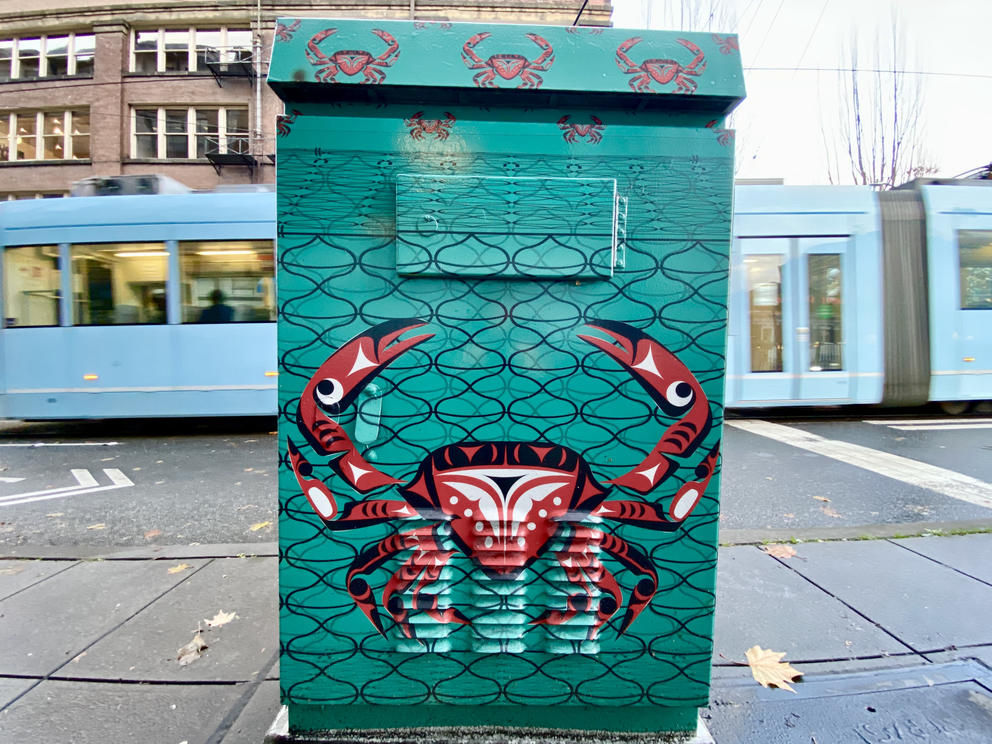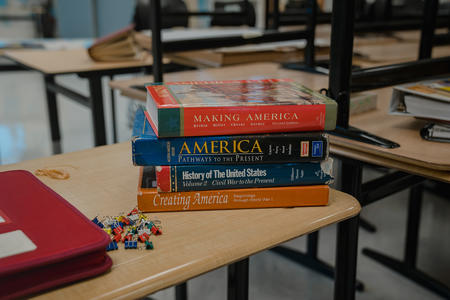See Native performance
Seattle Is Native Land: The 2020 Indigenous People Festival
What has the local arts and culture scene proved in 2020? “How strong and adaptable it is,” Hailey Tayathy, Quileute drag artist and Town Hall artist-in-residence, told Crosscut earlier this fall. To wit: the first online Indigenous People Festival, celebrating Indigenous creators and the Native land we live on. The two-day event features an array of performances, including drag, hoop and aerial dance by Tayathy, Ryan YellowJohn (Shoshone Bannock/Quechan), the Suquamish Tribe Song and Dance Group and a concert by indie singer-songwriter Quinn Christopherson (Athabaskan/Inupiat). Also in the mix are two timely talks: one about Black and Native solidarity in light of the Black Lives Matter movement; the other — with esteemed writers Rebecca Nagle (Cherokee Nation), Tommy Pico (Kumeyaay) and podcaster Alice Qannik Glenn (Alaska Native Iñupiaq) — about Native podcasting.
If you go: Seattle Is Native Land: The 2020 Indigenous People Festival, online, Nov. 20-21. (Free)
View Native Art
Guests From the Great River
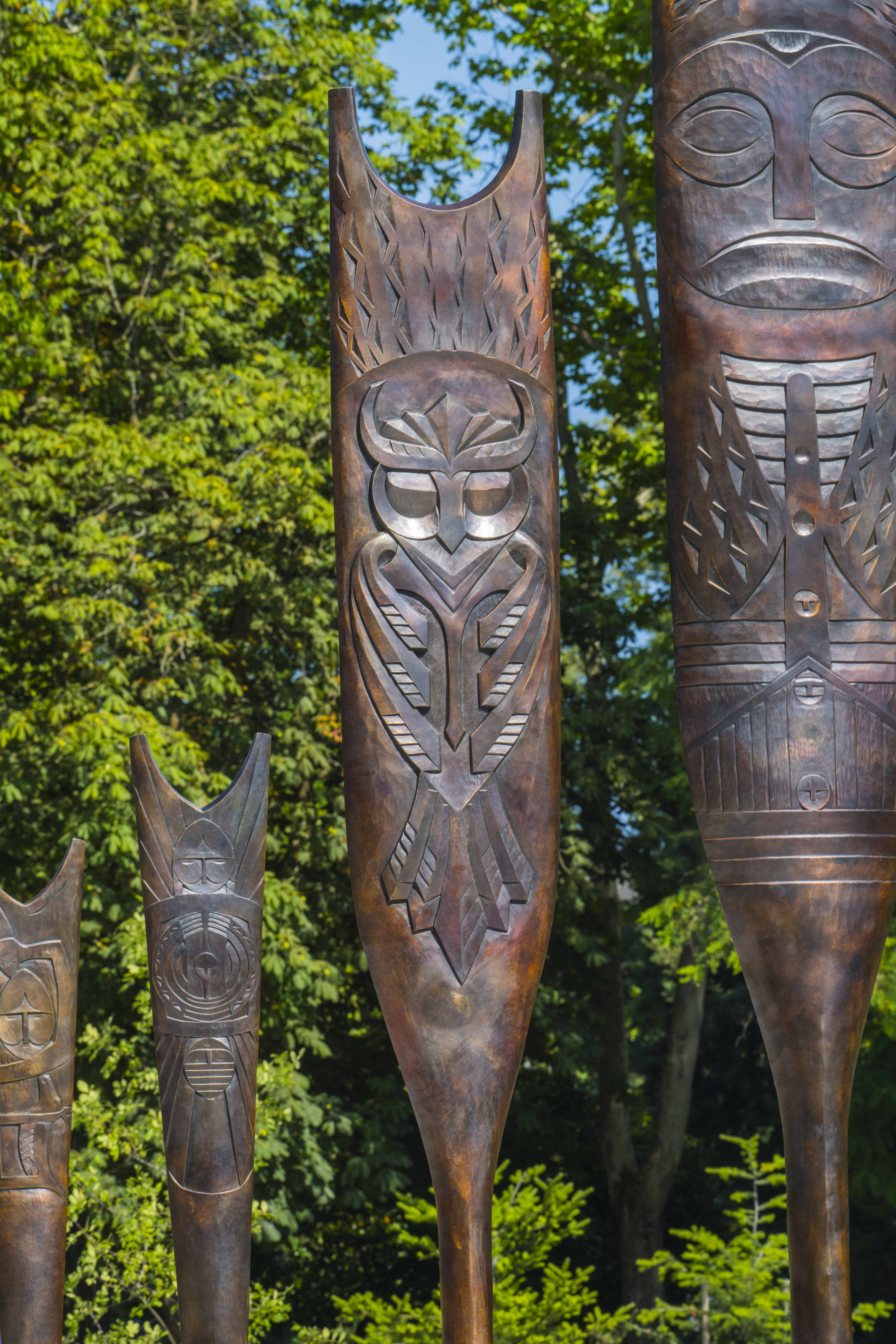
From afar the tall, bronze sculptures seem to form a sort of sparse forest. But up close, the 11 slender paddles standing vertically in front of the Burke Museum form the shape of a boat, representing the arrival of a Chinookan canoe — filled with stories and knowledge. The new outdoor installation, titled “Guests from the Great River,” created by Chinook artists Tony A. (naschio) Johnson (also the Chinook Indian Nation chairman) and Adam McIsaac, did arrive here from the lower Columbia River region. Johnson and McIsaac hand-carved the bronze paddles in wood first, then made 3D scans of the results and enlarged them up to 11 feet tall, then cast them in bronze. Each depicts a different story, and has a distinct notch used to grab hold of cottonwood roots along the Columbia River banks. The paddles are raised up as a symbol of peaceful greeting and respect, guiding visitors to the right place — as paddles tend to do.
Northwest Native Art Glass
There are obvious benefits to viewing an art exhibit from home (pajamas! coronavirus-proof!), but the details in the incredible glass sculptures on display in Northwest Native Art Glass are best viewed up close, with your head inching dangerously near these oh-so-delicate objects, made by three of the most renowned Indigenous glass artists working today: Dan Friday (Lummi), Preston Singletary (Tlingit), and Raven Skyriver (Tlingit). Only in person, at Stonington Gallery in Pioneer Square, did I notice the tiny pink sparkles embedded in the lithe, milky legs of a glass “Ika” (Squid) by Skyriver. In the spotlights of the gallery, Singletary’s blown and sand-etched baskets, glass versions of traditional Tlingit baskets woven from spruce tree roots, seemed even more ethereal than usual. And the reflections of Dan Friday’s patchworked baskets (also made of glass) extended far beyond their footprint of the pedestals, like sunshine through stained glass.
If you go: Northwest Native Art Glass, Stonington Gallery, through Nov. 28, Wed.-Sat., 11 a.m.-3 p.m. (Free)
Visible on Ancestral Lands: Coast Salish Public Art Works
Northwest Native art is all around us, marking and celebrating the long history of the region’s original peoples. You can plot a tour — armchair or outdoors — of many such public artworks with this online “story map,” released in June 2019. It documents 42 artworks by Native artists across Puget Sound and includes photos and stories from the makers about each piece. Check out the hand-carved red plaster mural “Four Corners” by Susan Point (Musqueam) at North Seattle College. Or legendary Quinault artist Marvin Oliver's “Spirit of Washington,” a 16-foot-tall cast-bronze sculpture of an orca’s dorsal fin that sits on a boulder behind the Seattle Public Library’s Columbia City branch. Or head to Queen Anne to see “Snoqual (Moon) the Transformer,” a sculpture by Roger Fernandes (Lower Elwha S'Klallam/Makah) that captures the Snoqualmie Tribe’s story of the moon’s birth, and how the moon altered the Earth to create Snoqualmie Falls. Reporting by Agueda Pacheco Flores.
If you go: Create your own art tour with the Visible on Ancestral Lands: Salish Public Artworks in King County map.
Art Outside the Box
Pioneer Square bills itself as “Seattle’s first neighborhood” (an area settlers originally called “Duwamps”), so it seems appropriate that the neighborhood pay tribute to the original inhabitants of the region. The new Art Outside the Box project, led by the Pioneer Square Residents’ Council in collaboration with Chief Seattle Club, elevates dull gray signal boxes with vivid designs created by enrolled members of Coast Salish tribes. The first installment happened in 2019, with five designs (chosen by a jury of Native artists, Indigenous leaders and Pioneer Square residents) placed on the Seattle Department of Transportation utility boxes along First Avenue. This past summer the project added six more new installations along Jackson Street. Titus Capoeman (Quinault Indian Nation) created a bright ode to his tribal crabbing community. Longtime local artist Maynard Johnny Jr. (Penelakut First Nation) contributed a bold “Walking Bear,” blending traditional formline shapes with contemporary use of color. And Jason Read (Sechelt Indian Band of the First Nations) combined eagle imagery with neighborhood icons: brick buildings and the iconic pergola.
Diversity
The formline heron’s head is all eye: a large, unblinking black dot with purple lids. The bird also has a pupil on its neck and an eye on its belly. In another painting, a one-eyed owl looks knowingly at the viewer. In another, titled “Passion,” an octopus’s eyes are circled in red, as if he hasn’t slept in ages. In the sleek and bright Kwakwaka’wakw-style paintings of Steve Smith (Kwakwaka’wakw/Oweekeno), there’s no escaping the probing gaze of the stylized creatures. With the new show Diversity, Smith (also known as Dla’kwagila or "Made to be Copper” in the Kwak'wala language) celebrates the wildlife that populates the Pacific Northwest as a reminder of the wisdom we can gain from nature. The interdependence and survival of animal species, Smith says, offers us a path of hope — particularly after this long year. As Smith puts it in his artist statement: “Throughout the disruptions and chaos that 2020 thrust upon us, one thing has kept us strong and moving ahead: our diversity.”
If you go: Diversity, Steinbrueck Native Gallery, Mon.-Sun., 11 a.m.-5 p.m. and by appointment. (Free)
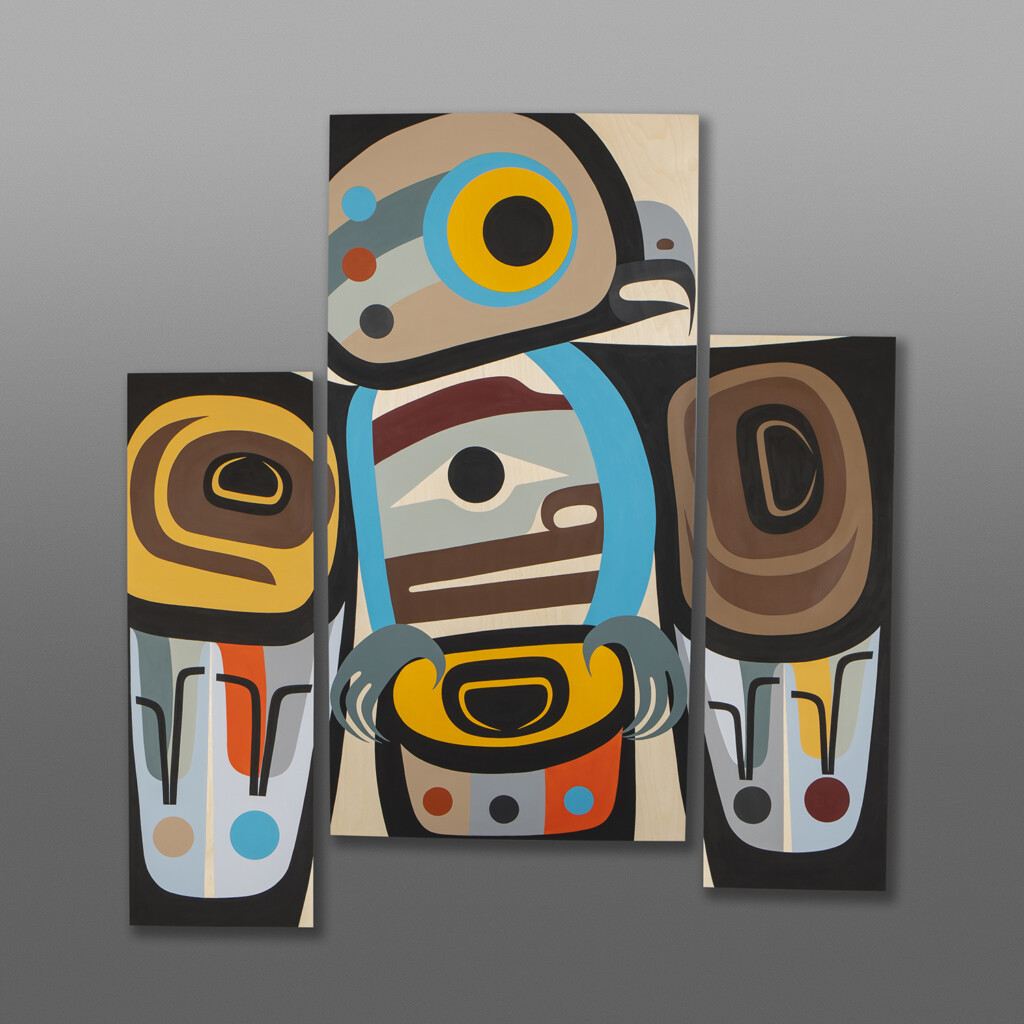
More Native art
>> This past spring Tacoma’s 950 Gallery opened a show called Rhoda. Organized by artist Paige Pettibon (Salish from the Confederated Salish and Kootenai Tribes of Flathead Reservation), the collection featured work by her grandmother, Rhoda Hayward, as well as those of other extended family members and some of her own pieces. The pandemic may have closed Rhoda, but the incredibly detailed cradleboards, beadwork and crocheted artworks are viewable online. (Read more about the show from local artist and author Asia Tail).
>> The 20th edition of The National Museum of the American Indian’s Native Cinema Showcase will be happening online only (Nov. 18-27, free), which means Pacific Northwesterners can now easily access this celebration of the best in Native film, from Indigenous shorts to documentaries and the witty, gory zombie movie with a twist, Blood Quantum.
>> Not Your Monolith!, a new exhibition at CoCA gallery now viewable online, features work by various Black, Indigenous and people of color artists, including various artists affiliated with the Crow Shadow Institute of the Arts, located on the Confederated Tribes of the Umatilla Indian Reservation in Oregon: “Zen Scrubber #3” by Brenda Mallory, a citizen of the Cherokee Nation, brings an unexpected softness to recuperated industrial hardware. Also notable are Sara Siestreem’s (Hanis Coos) dark acrylic and graphite painting, “but the volcanoes,” which erupts in bursts of red and milky rains; Lillian Pitt’s (Warm Springs, Wasco and Yakama) beautiful print of moving river spirits that seem to move on the canvas; and Shirod Younker’s (Coquille/Coos) mesmerizing lithograph featuring a Mason jar of canned salmon floating on a Rorschach test-like sheet of seaweed. Keep your eyes on the CoCA website for announcements of virtual artist talks in the coming weeks.
A lithograph titled “Gelyek Yat!” (Salmon and Seaweed in Miluk, a Coosan language) by Shirod Younker (Coquille/Coos) shows a Mason jar of canned salmon floating on a Rorschach test-like sheet of seaweed. Although it's a wink to Warhol’s soup cans, it's mostly an ode to “first foods” and the care and process with which they were produced. (Shirod Younker)
Hear Native stories
Changer and the Star People
“This is a moment for storytelling,” theater maker Fern Naomi Renville (Sisseton Wahpeton Oyate/ Omaha/Seneca Cayuga) told me recently. By “this” she meant the coronavirus closures that have kept plays like Changer and the Star People — an Indigenous Futurist play featuring Dakota and Coast Salish origin stories — off the stage. Like other local theater makers who have pivoted from the stage to audio theater, Renville and Roger Fernandes (Lower Elwha S'Klallam/Makah) have reworked the show as a radio play premiering this month. In it, the all-Indigenous cast imagines a not-too-distant future wherein tribes can truly exercise their sovereign treaty rights. “What I wanted as a Dakota playwright was to create the world I want to live in,” Renville said. She envisioned a positive place for and by Indigenous people where “we’re not talking about our trauma and unpacking it for people, or trying to engage you in the struggle for justice — we’re laughing and having fun.”
If you go: Changer and the Star People, Sound Theatre, premieres Nov. 20. (Free with suggested donation)
Natives Were Never Homeless Before 1492
“We’re still here, after 500 years or so. We’ve been through a lot of struggles in our grandmother’s and grandfather’s days, generations back. We had epidemics, measles, chicken pox, SARS, MRSA and now this virus — corona,” says Feanette Black Bear in a new four-part podcast series dedicated to the resilience of urban Native people who are unhoused in Seattle during the pandemic.
The title, “Natives were never homeless before 1492” (also available on a T-shirt), is a reference to the year Columbus set foot in the Americas (thinking he’d landed in India), which began centuries of European colonization and genocide. Produced by Colleen Echohawk of the Chief Seattle Club and created by SeaTac-based artist Raven Two Feathers, the podcast consists of conversations with people working at and members of the Chief Seattle Club (the nonprofit that provides services for American Indian and Alaska Native people) about how COVID-19 has complicated their life and work. But, as Black Bear puts it: “We are strong people — all of us, all Indigenous people worldwide.” You can listen to the series free online.
More native stories:
>> A missing chapter in most music history books: the role Native Americans played in shaping rock ’n’ roll. The PBS documentary Rumble: The Indians Who Rocked the World tells that story in a way that’s both eye-opening and hip shaking. It’s viewable free online.
>> Speaking of excellent docs: Crosscut documentary The Rising chronicles how members of the Quinault tribe, facing climate upheaval and increased tsunami risk on Washington's coast, take to the sea in the canoes of their ancestors.
>> The Burke Museum may be closed and, let’s face it, you may be sick of online events, but some of the YouTube videos of the Burke’s Bill Holm Center for the Study of NW Native Art are wonderfully informative, screen fatigue or not. Find more videos and tutorials (including one on how to harvest and make pesto from local nettles) made in partnership with Native artists and storytellers on the Burke from Home page.
Order Native takeout
The Burke Museum may be closed for now, but the museum’s Off the Rez café — the first brick-and-mortar location of Seattle’s first Native food truck and catering company — is still going strong with takeout and delivery of tasty dishes with an Indigenous twist, including a braised bison wild rice bowl with pickled onions, “Indian Tacos” and a variety of handmade fry bread options, including an apple pie version. Keep an eye out for new dishes and the whereabouts of the Off the Rez food truck on the website and social media.
Design brand Eighth Generation (owned by the Snoqualmie Tribe) launches a new collection of wool blankets made in Seattle. Shown here is a baby blanket designed by textile artist Gail White Eagle (Muckleshoot and Chehalis). (Emilia Wronski/ Eighth Generation)
Shop Native art and craft
>> It was big news last year when the Snoqualmie Tribe purchased Eighth Generation, a hub for Native-designed art and lifestyle products with a brick-and-mortar store at Pike Place Market since 2016. While the physical boutique remains closed by the pandemic, Eighth Generation’s online store is one of Seattle’s go-to shops for Native-designed prints, phone covers, jewelry, T-shirts, gorgeous wool blankets and all manner of arts and crafts that are — as founder Louie Gong says — made by “inspired Natives,” as opposed to “inspired by” Native culture. New this year: an in-house line of 100% Merino wool baby blankets and scarves made in its Seattle studio headquarters — a first for Eighth Generation.
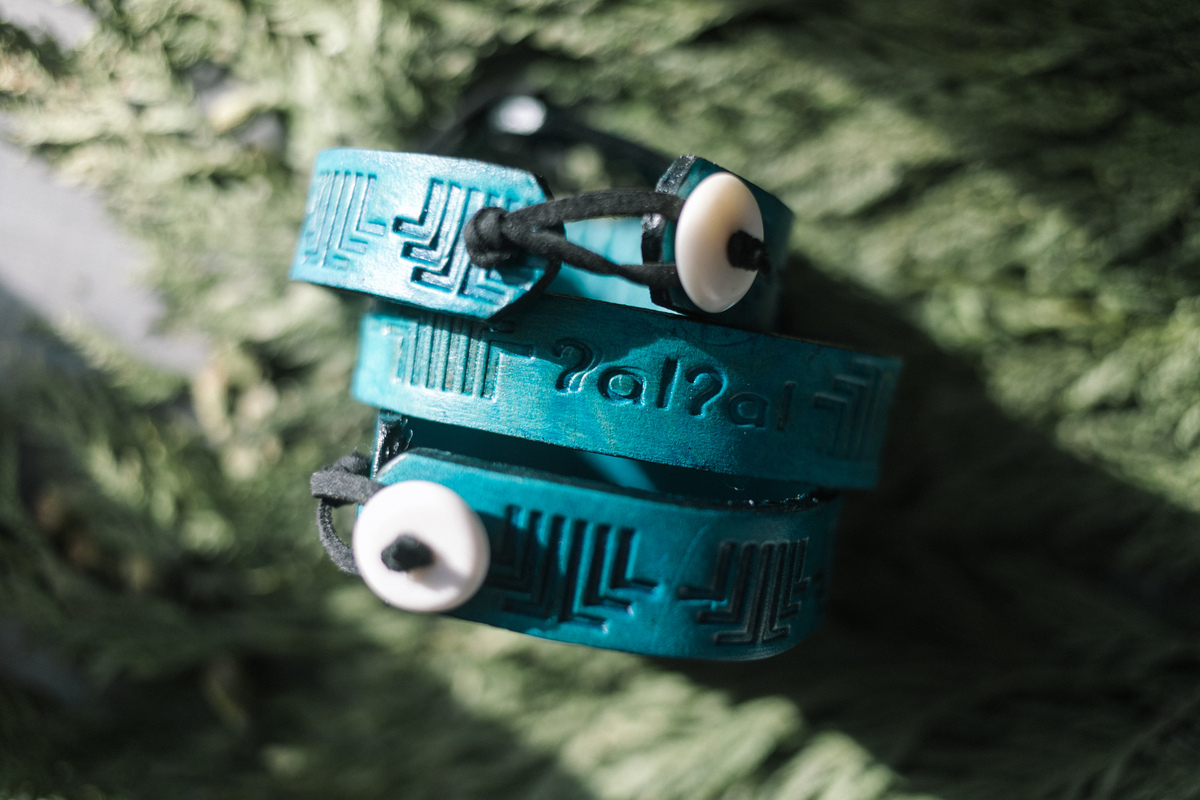
>> Located near the northern edge of Pike Place Market’s new Marketfront building, Native Works is still going strong at the market every weekend (and will be there through January). The stall, which benefits Chief Seattle Club, features the online shop’s bestsellers, including T-shirts, beaded jewelry and leather bracelets stamped with "home" in the Lushootseed language, all crafted by apprentices at the Chief Seattle Club. Open Fri-Sun, 10 a.m.-5 p.m. (closed Nov. 26) and online at www.nativeworkscsc.org
>> The airport’s first Native American-owned retail shop, the Sea-Tac Sacred Circle Gallery and Gift Shop (Open daily 7 a.m.-4 p.m.) is open (though health officials recommend that staying home this Thanksgiving), as is the Sacred Circle Gallery and Gift Shop at the Daybreak Star Indian Cultural Center in Discovery Park (Open Thurs. - Sun., 10 a.m. - 4 p.m.). Both stores offer Native-designed items, including jewelry, clothing and gifts, which an also be found on the online store.
>> The Suquamish Museum (located on the Port Madison Indian Reservation, steps from Chief Sealth’s grave) is currently closed. But its gift shop is open by appointment and virtually, thanks to a newly launched virtual shopping experience. Among the offerings: work by many Suquamish artists, including wool and cedar weavers, beadworkers, wood and bone carvers and painters. Open Fri.-Sun., only by reservation. (Closed Nov. 26 and 27)
>> Though the Tacoma and Seattle art museums remain closed, you can still find artistic objects at the museums’ online stores. At the TAM Store, find luscious, translucent glass baskets (for big spenders) by famed local glass artist Preston Singletary and more work by Indigenous makers, including the near-monochrome paintings by Raven Juarez and weavings of yellow cedar bark and spruce root by Lisa Telford. The SAM shop showcases, among other things, carved cedar pins and paddles by Firewoman Studio (Tsalagi/Salish/Dutch), T-shirts by Shaun Peterson and Preston Singletary and extremely cool basketballs adorned with traditional formline designs by Trickster, a Native design company based in Juneau, Alaska.
Get the latest in local arts and culture
This weekly newsletter brings arts news and cultural events straight to your inbox.


